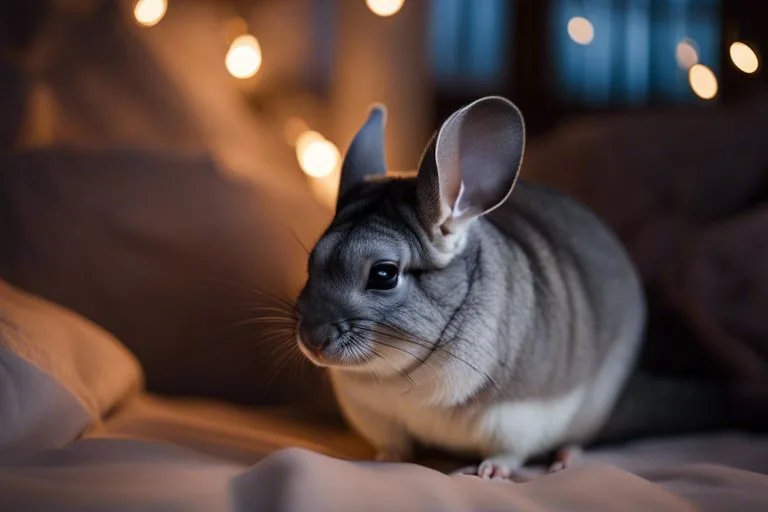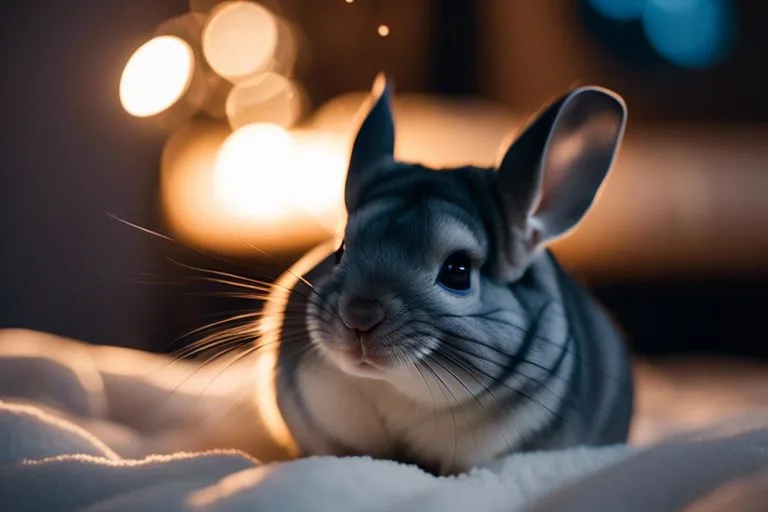Shadows play an important role in a chinchilla’s natural habitat, but do these adorable creatures actually live in the dark? Chinchillas are crepuscular animals, meaning they are most active during dawn and dusk. While they have excellent night vision, too much darkness can lead to fear and stress in chinchillas. Find out how to provide the appropriate lighting and environment to keep your chinchilla happy and healthy.
Key Takeaways:
- Chinchillas are crepuscular animals: They are most active during dawn and dusk, preferring low light conditions for their activities.
- Darkness is not necessary for chinchilla’s habitat: While they may be more active in dim light, chinchillas do not require complete darkness to thrive and can adapt to various light conditions.
- Provide a well-lit environment during the day: To mimic their natural habitat and promote their well-being, it is important to offer bright light during the day and allow for periods of dim light during their most active times.
Natural Habitat
Chinchillas native environment
While chinchillas have been domesticated and are commonly kept as pets in a wide range of environments, they originally hail from the mountainous regions of the Andes in South America. These small rodents are native to areas with high altitudes, rocky terrains, and sparse vegetation, making their natural habitat quite different from the typical home they are provided in captivity.
Lighting conditions in the Andes
For chinchillas living in the Andes, the lighting conditions are vastly different from what they experience in captivity. The high altitudes and extreme terrain of the Andes means that lighting conditions fluctuate significantly throughout the day. Chinchillas in the wild experience intense sunlight during the day due to their habitat’s altitude, which exposes them to high levels of UV radiation.
One key aspect of the Andean lighting conditions is the periods of darkness that occur during the night. These periods of darkness play a crucial role in the natural rhythm of chinchillas, influencing their activity levels and behaviors.
Burrowing Behavior
Why chinchillas dig burrows
Little known to many, chinchillas in the wild are expert burrowers. They dig burrows primarily for shelter and protection against predators and extreme weather conditions. The burrows also serve as their nesting and breeding grounds, providing a safe and secluded environment for their offspring.
Burrow structure and lighting
To maintain their burrows, chinchillas use their teeth and claws to dig and shape the tunnels. An ideal burrow is typically a system of interconnected tunnels with different chambers for sleeping, eating, and even bathroom areas. Chinchillas are known to prefer dimly lit environments, and their burrows are designed to provide just that. This low-light setting mimics their natural habitat in the rocky terrains of the Andes Mountains.
Lighting plays a crucial role in a chinchilla’s burrow as it helps to regulate their sleep patterns and ensure they feel safe and secure. While they are crepuscular animals, meaning they are most active during dawn and dusk, chinchillas still require some darkness during the day to rest and feel secure in their burrows.
Visual Adaptations
Chinchillas eye structure
For chinchillas, vision is an imperative sense for their survival in the wild. Their eyes are positioned on the sides of their heads, giving them a wide field of vision to detect predators from all directions. Moreover, chinchillas have large eyes in proportion to their body size, aiding them in spotting movement and potential threats in their environment.
Adapting to low light conditions
Adaptations to low light conditions are crucial for chinchillas, as they are crepuscular animals that are most active during dawn and dusk when light levels are lower. Chinchillas have large pupils that can dilate and contract rapidly to allow more or less light into their eyes, helping them adjust to changing light conditions quickly. Additionally, these small rodents have a high density of rod cells in their retinas, which are specialized for low-light conditions and motion detection.
To further aid their vision in dim light, chinchillas have a reflective layer behind their retinas called the tapetum lucidum. This layer enhances their night vision by reflecting light that passes through the retina back onto the light-detecting cells, maximizing their ability to see in the dark.

Activity Patterns
Diurnal or nocturnal?
One common misconception about chinchillas is that they are nocturnal due to their preference for low light conditions. However, chinchillas are actually crepuscular, which means they are most active during dawn and dusk. This is a typical behavior for prey animals in the wild, helping them avoid predators while still having enough light to forage for food and socialize with their group.
Peak activity times
At what times of the day are chinchillas most active? Chinchillas tend to be most active during the early evening and early morning hours. During these times, they engage in various activities such as running, jumping, grooming, and playing with their cage mates. It is important to understand their peak activity times to ensure they have enough mental and physical stimulation in their environment.
Peak activity times are crucial to a chinchilla’s well-being as it allows them to engage in natural behaviors and expend excess energy. Providing opportunities for play and exercise during these times can help prevent behavioral issues such as boredom and aggression. By aligning their environment with their natural activity patterns, chinchillas can lead healthier and happier lives.
Captivity and Lighting
Once again, chinchillas are crepuscular animals, meaning they are most active during dawn and dusk. When kept in captivity, it is necessary to replicate their natural environment as much as possible to ensure their physical and mental well-being.
Housing chinchillas in captivity
For chinchillas housed in captivity, providing a well-sized cage with multiple levels, hiding spots, and platforms to jump and play on is crucial. This setup mimics their natural habitat in the Andes Mountains, where they are accustomed to climbing and exploring rocky terrains.
Providing suitable lighting conditions
Housing chinchillas in a room with natural light is ideal, as it helps regulate their internal clock and provides a sense of day and night. If natural light is not available, full-spectrum lighting can be used to mimic natural sunlight. However, it’s important to provide a dark, quiet environment for them to rest and sleep.
To avoid disrupting their natural cycle, it is best to expose chinchillas to 12 hours of light and 12 hours of darkness each day. This ensures that they have enough light to be active and play during their active periods while also allowing them to rest properly during their inactive hours.
Health Implications
Effects of inadequate lighting
After being accustomed to low-light conditions in the wild, chinchillas do not require extensive lighting in captivity. However, inadequate lighting can still have negative effects on their health. Chinchillas need some exposure to natural light to regulate their circadian rhythm, support Vitamin D production, and prevent behavioral problems. Without enough light, chinchillas may experience issues like lethargy, depression, and disrupted sleep patterns.
Preventing health problems
On the other hand, exposing chinchillas to too much light can also be harmful. Chinchillas are crepuscular animals, meaning they are most active during dawn and dusk. Excessive lighting can disrupt their natural behavior patterns and lead to stress. To prevent health problems related to lighting, it is crucial to provide a balance of natural and artificial light in their environment.
Any sudden changes in lighting should be avoided to prevent unnecessary stress on chinchillas. It is best to gradually adjust their light exposure to mimic natural conditions. Additionally, providing hiding spots and shelters in the cage where chinchillas can retreat to if they feel overwhelmed by light is vital. This allows them to regulate their exposure according to their comfort levels and natural instincts.
This emphasizes the importance of striking a balance in lighting for chinchillas to maintain their overall well-being and prevent potential health issues. By understanding their natural behavioral patterns and light requirements, chinchilla owners can create a suitable environment that supports their physical and mental health.
To wrap up
So, while chinchillas do not necessarily live in complete darkness, they do prefer low-light environments due to their crepuscular nature. This means that they are most active during dawn and dusk, seeking shelter in dark areas during the day to rest and relax. It’s important to provide your chinchilla with a dimly lit cage or room to mimic their natural habitat and promote their well-being.
Understanding a chinchilla’s preference for darkness can help you create a suitable living environment that meets their needs. By providing the right lighting conditions and ensuring they have a cozy, dim space to retreat to, you can help your chinchilla thrive and lead a happy and healthy life.
FAQ
Q: Do Chinchillas live in the dark?
A: Chinchillas are crepuscular animals, which means they are most active during dawn and dusk. While they do not necessarily live in complete darkness, they are naturally adapted to low-light conditions.
Q: What type of housing environment is best for Chinchillas in terms of light?
A: Chinchillas should be provided with a housing environment that offers a balance of light and shade. They should have access to natural light during the day but also be able to retreat to darker areas when they need to rest or sleep. Avoid exposing them to direct sunlight or harsh lighting.
Q: How can I ensure my Chinchilla’s light needs are met in captivity?
A: To meet your Chinchilla’s light needs in captivity, place their enclosure in a well-lit room with access to natural daylight. Provide hiding areas or shelters within the enclosure where they can retreat to darker spots if needed. Avoid placing their habitat in direct sunlight or using bright artificial lighting for extended periods.
